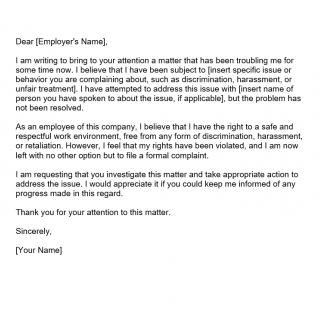Employee complaint letter
An employee complaint letter is a written document used to formally raise concerns or grievances about a workplace issue or situation. The main purpose of this form is to provide employees with a platform to voice their concerns and to initiate a formal process for resolving the issue.
The form consists of several parts, including a description of the workplace issue or situation, the names and positions of the individuals involved, and the desired outcome or resolution. It is important to note that the form must be completed in its entirety, and all information provided must be accurate and truthful.
When compiling the form, the employee will need to provide certain data such as their full name, job title, and contact information. Additional documents that may need to be attached to the complaint letter include any relevant evidence or documentation that supports the employee's claim.
Sample Employee complaint letter
Dear [Employer's Name],
I am writing to bring to your attention a matter that has been troubling me for some time now. I believe that I have been subject to [insert specific issue or behavior you are complaining about, such as discrimination, harassment, or unfair treatment]. I have attempted to address this issue with [insert name of person you have spoken to about the issue, if applicable], but the problem has not been resolved.
As an employee of this company, I believe that I have the right to a safe and respectful work environment, free from any form of discrimination, harassment, or retaliation. However, I feel that my rights have been violated, and I am now left with no other option but to file a formal complaint.
I am requesting that you investigate this matter and take appropriate action to address the issue. I would appreciate it if you could keep me informed of any progress made in this regard.
Thank you for your attention to this matter.
Sincerely,
[Your Name]
Application examples and use cases for the employee complaint letter include situations such as workplace discrimination, harassment, or unfair treatment. This form is also useful for raising concerns about workplace safety, work conditions, or other issues that may be affecting employee morale and productivity.
Strengths of the employee complaint letter include its ability to provide a formal process for resolving workplace issues and to empower employees to voice their concerns. However, a weakness of the form is that it may not always lead to a satisfactory outcome, and in some cases, it may result in retaliation or negative consequences for the employee.
Alternative forms that may be used in place of the employee complaint letter include informal communication with a supervisor or HR representative or filing a complaint with a government agency such as the Equal Employment Opportunity Commission (EEOC).
The future of the participants may be affected by the outcome of the complaint letter, as it may result in a change in workplace policies or procedures or in the resolution of the issue at hand. The form is typically submitted to a supervisor or HR representative and is stored in the employee's personnel file.
In conclusion, the employee complaint letter is an important document that empowers employees to voice their concerns and initiate a formal process for resolving workplace issues. It is essential that the form is completed accurately and truthfully and that all required information is provided. The form does not need to be notarized.

